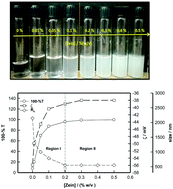Solvent hydrophobicity induced complex coacervation of dsDNA and in situ formed zein nanoparticles†
Abstract
Zein, a predominantly hydrophobic protein, was sustained as a stable dispersion in ethanol–water (80 : 20, % (v/v)) binary solvent at room temperature (25 °C). Addition of aqueous dsDNA solution (1% (w/v)) to the above dispersion prepared with the protein concentration of Czein = 0.01–0.5% (w/v) caused a concomitant change in ethanol content from 14–35% (v/v), which in turn generated zein nanoparticles in situ of size 80–120 nm increasing with water content. The subsequent associative interaction between DNA (polyanion; 2000 bps) and the positively charged zein nanoparticles, (at pH = 4) was driven by Coulombic forces, and by the solvent hydrophobicity due to the ethanol content of the binary solvent. Experimentally, two interesting regions of interaction were observed from turbidity, zeta potential, particle sizing, and viscosity data: (i) for Czein < 0.2% (w/v), zein nanoparticles of size 80 nm bind to dsDNA (primary complex) causing its condensation (apparent hydrodynamic size decreased from ≈2100 to 560 nm), and (ii) for 0.2% < Czein < 0.5% (w/v) larger nanoparticles (>80 nm) were selectively bound to primary complexes to form partially charge neutralized interpolymer soluble complexes (secondary complexes), followed by complex coacervation. During this process, there was depletion of water in the vicinity of the nucleic acid, which was replaced by hydration provided by the ethanol–water binary solvent. Equilibrium coacervate samples were probed for their microstructure by small angle neutron scattering, and for their viscoelastic properties by rheology. The interplay of solvent hydrophobicity, electrostatic interaction, and zein nanoparticle size dependent charge neutralization had a commensurate effect on this hitherto unexplored coacervation phenomenon.



 Please wait while we load your content...
Please wait while we load your content...